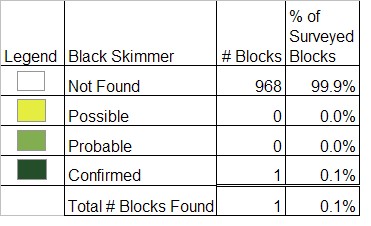Find a Bird - BBA1
Breeding Bird Atlas 1 Species Accounts
Black Skimmer
Rynchops niger
Egg Dates
June 8 to August 16
Number of Broods
one; may re-lay if first attempt fails.

The Black Skimmer is an erratic visitor and rare breeder on the coast of Massachusetts, most often encountered along sandy beaches or open tidal flats. In eastern North America, the regular breeding range extends from Long Island, New York, southward along the coast to the Gulf of Mexico. Historically, Champlain recorded skimmers in Massachusetts on Cape Cod in 1605. By the late eighteenth century, the species was extirpated from this, its northernmost breeding ground.
Between 1946 and 1984, skimmers were recorded nesting in Massachusetts on 16 occasions. Most nesting attempts (including the 1976 Atlas record) have occurred on Monomoy. Plymouth Beach has had six nestings, and two nests have been recorded at Cotuit. Since 1984, when skimmers were observed breeding on North Monomoy and New Island, the species has nested annually.
Spring migrant skimmers are rarely seen. Most sightings occur from June to September. Barrier beaches are the preferred nesting habitats along the mid-Atlantic and southern coasts of the United States, while coastal dredge spoils along the Gulf of Mexico support large colonies. In our area, skimmers usually nest in the company of Common Terns.
A hollow depression in the sand serves as a nest, and a normal clutch consists of three to five buffy brown blotched eggs. Sets of two or three eggs were encountered most often in Massachusetts between 1946 and 1984. This and the fact that many of these nesting records occurred in July or August are an indication that they represented renesting attempts of failed and displaced southern breeders or late breeding attempts by inexperienced younger birds. In recent years, it appears that a small population of Massachusetts breeders has become established, and egg laying may begin in early June (Hecker, Nisbet). The nest discovered on Monomoy on August 16, 1976, contained two eggs. Other recent Monomoy egg dates include: three eggs hatched either on or before June 30, and two eggs observed on June 20 (Humphrey). A nest on New Island off Orleans contained four eggs on June 8 (Hecker). Both sexes incubate for 22 to 25 days and care for the young, feeding them regurgitated food at first and later bringing small fish. By kicking sand up over their backs, the precocial chicks hide themselves from predators.
One often hears the Black Skimmer before seeing it. Its common calls, low, nasal kaup, aur, and kak notes, are likened to barking and certainly stand out among those of other summer coastal birds. The feeding habits are also unique, with the birds skimming low over the water to snap up small fish and crustaceans.
In August and September, small flocks of adults and immatures occur along the Massachusetts coast. Postbreeding dispersal is common among colonial nesters, and skimmers from farther south frequently move northward before beginning their fall migration, which takes them from the Gulf of Mexico to the coasts of South America, where they form flocks of several hundred. Large numbers of skimmers occasionally are driven to our shores after hurricanes or intense storms in late summer or early fall. When this occurs, small flocks frequently remain for extended periods, with a few individuals rarely lingering into December.
Map Legend and Data Summary
Atlas 1 data collected from 1975-1979


Note: rare and irregular, and local; always associated with large tern colonies
Peter Trull



